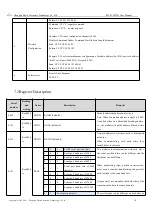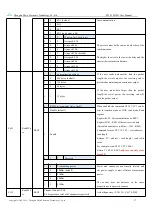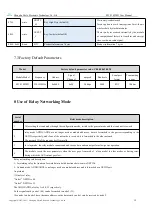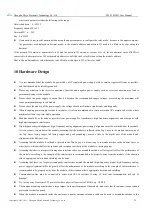
Chengdu Ebyte Electronic Technology Co.,Ltd.
E22-230T30D User Manual
Copyright ©2012–2021
,
Chengdu Ebyte Electronic Technology Co.,Ltd.
18
06H
Read/Wri
te
REG3
7
Enable RSSI bytes
When enabled, the module receives wireless data,
which will follow an RSSI intensity byte when
output through the serial port TXD.
0
Disable (default)
1
Enable
6
Transmission method
For fixed-point transmission, the module
identifies the first three bytes of the serial data as:
address high + address low + channel, and uses
them as the wireless transmitting target.
0
Transparent transmission (default)
1
Fixed-point transmission
5
Relay function
When the relay function is enabled, the module
will initiate a forwarding if the destination address
is not the module itself.
To prevent data backhaul, it is recommended to
use with fixed-point mode; i.e., the destination
and source addresses are different.
0
Disable relay function (default)
1
Enable Relay Function
4
LBT enable
When enabled, wireless data is listened to before
it is transmitted, which can avoid interference to
some extent, but may introduce data delays.
The maximum dwell time of LBT is 2 seconds,
and it will be forced to issue when it reaches two
seconds.
0
Disable (default)
1
Enable
3
WOR mode transceiver control
Only valid for mode 1;
After the WOR receiver receives the wireless data
and outputs it through the serial port, it will wait
for 1000ms before entering the WOR again.
During this period, the user can input the serial
port data and return it through the wireless;
Each serial port byte will refresh 1000ms time;
The user must initiate the first byte within
1000ms.
0
WOR receiver (default)
The transceiver is turned on, and a wake-up
code for a certain period of time is added when
transmitting data.
1
WOR transmitter
The module cannot transmit data and works in
the WOR monitoring mode. The monitoring
period is shown below (WOR period), which
can save a lot of power consumption.
2
1
0
WOR Cycle
Valid only for mode 1.
Cycle time T= (1+WOR)*500ms, maximum
4000ms, minimum 500ms.
The longer the WOR listening interval cycle time,
the lower the average power consumption, but the
greater the data latency.
Both sending and receiving parties must agree
(very important)
0
0
0
500ms
0
0
1
1000ms
0
1
0
1500ms
0
1
1
2000ms
1
0
0
2500ms
1
0
1
3000ms
1
1
0
3500ms
1
1
1
4000ms









































